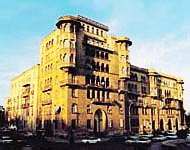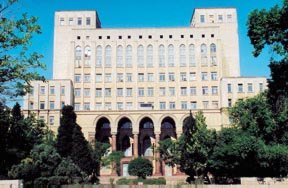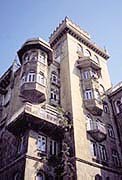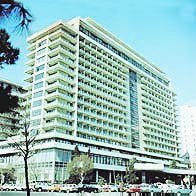|

Winter
1998 (6.4)
Pages
46-47
The Soviet
Period of Architecture in Azerbaijan
The Twists
and Turns of the Career of Mikayil Useynov (1905-1992)
by Ilham Aliyev, President
of Architects Union
Left: Mikayil Useynov.
Right: Academy of Science Building the crown
of which was not completed because Khruschev came into power.
As a leading
architect in Soviet Azerbaijan, Mikayil Useynov (pronounced oo-SEH-nov)
was especially vulnerable to changes in the political sphere.
Praise for his work could quickly turn into harsh criticism depending
upon the tastes and preferences of whoever happened to be in
power. By looking at the twists and turns of Useynov's long and
distinguished career, we can trace the curious path that Azerbaijani
architecture took during the Soviet period.
If you have
a chance to pass the Academy of Sciences complex on Hussein Javid
Prospect in Baku, you'll notice that one of its buildings looks
a bit peculiar. Take a closer look and you'll see that there's
something not quite right. Except for its arched entranceway,
the building has a fairly "boxy look" in keeping with
much of Baku's Soviet-era architecture but the four towers are
squared off at the top, like pedestals waiting for something
to be mounted on top of them. The building looks that way for
one simple reason-it was never finished.
Left: Nizami Cinema.
Right: Akhundov National Library
The architect,
Mikayil Useynov, had something much different in mind when he
originally designed the building. The four towers were to be
adorned with pergolas (archwork) and topped with domes as many
of the other buildings are throughout the city. But Khrushchev
came into power (1955) while the building was being erected,
and these final ornamental elements contradicted Party policy.
There was a great need at that time for housing and according
to Khrushchev, aesthetics were extraneous. People simply needed
a place to live - never mind what it looked like. And thus, the
Academy fell victim to the same dictatorial mandates and thus
stands today, unfinished-a reminder of a time when fancy "ornamentation"
was not politically correct.
Useynov was a prominent Azerbaijani architect caught in the middle
of a struggle to meet the approval of the Communist party and
yet still do work that he could feel proud of. His body of work,
which includes nearly 200 buildings, is very typical of Azerbaijan's
architecture during the Soviet period. It reflects the battle
between an artist's will to create and the ever-changing will
of the ruling authorities.
Left: Detail from one of the "Vase Apartments"
by Uzeynov.
Right: Azerbaijan Hotel
Building a Career
Mikayil
Useynov was born in Baku in 1905 and studied architecture at
the Azerbaijan Polytechnic Institute. After graduating in 1929,
he continued working there as a lecturer. Soviet power had just
been established, so its influence on Azerbaijan's architecture
was just becoming evident. Since Azerbaijan was a major industrial
center for the Soviet Union, considerable construction was going
on at the time.
In the late 1920s, Useynov and his colleague Sadikh Dadashov
became well known for their study of the Shirvan Shah Palace,
a 14th century complex in Baku's Inner City. They took detailed
measurements for the reconstruction of the burial vault (tyurbe)
and the palace court (divankhane), and wrote a book about it.
At about the same time, Useynov and Dadashov won first place
in a contest to design a mausoleum for 12th century Azerbaijani
poet Nizami. The mausoleum was erected in 1926 in Ganja, Nizami's
birthplace. The two then worked together on numerous other projects
until Dadashov died in 1946, including the Azerbaijan Pavilion
at the All-Union Agricultural Exhibition in Moscow in 1939 which
won a State prize.
Useynov's early work is associated with a style of architecture
called Constructivism, which was popular in the Soviet Union
in the 1920s and early 1930s. Constructivism grew out of the
Russian avant-garde movement. As part of the revolution to seek
new forms and materials, art was stripped down to its most basic
elements. In architecture, construction materials were made visible
as part of the overall design, illustrating the importance of
industrial power. Some examples of Useynov's buildings from
the early portion of his career include the Nizami Cinema (1934),
the dormitory for the Azerbaijan Medical College (1934) and the
Maternity Hospital in Bayil.
 |
 |
Left: Music Academy named after Uzeyir Hajibeyov.
Top: The Scholars' Residence
Changing Tastes
Constructivism
soon fell out of favor. In 1934, the Communist Party issued a
decree criticizing this style of architecture, calling for a
return to national traditions and roots. From then on, buildings
were designed in a "national style," incorporating
elements like those found in the medieval Shirvan Shah Palace;
specifically, arches, columns, inner courtyards and fountains.
Azerbaijan's unique regional climate was also factored into this
"national style." Buildings were designed to provide
protection from the sun and harsh wind. Closed courtyards, oblique
streets and roofs with wide, sloping ledges all helped to shield
inhabitants from the elements.
There are many examples of Useynov's work from this "national
style" period including the Palace of Soviets of Azerbaijan
(1934), Azer-baijan State Music Academy (1936), Nizami Museum
(1940), the Akhundov Public Library (1947) and the complex of
buildings at the Azerbaijan Academy of Sciences (1948-1960) (including
the unfinished building mentioned earlier).
By this time, Useynov was entering into more and more official
roles as part of his career. He helped found the Union of Architects
of Azerbaijan in 1936 and served as its secretary for nearly
50 years. By 1939, he was a professor at the Institute and in
1945 was elected a full member of the Azerbaijan Academy of Sciences.
In 1948, Useynov became Director of the Institute of Architecture
and Arts of the Academy of Sciences of the Azerbaijan Republic,
a position he would hold for more than 40 years. He also gained
a strong reputation throughout the Soviet Union and on several
occasions was elected Secretary of the USSR Union of Architects.
 |
 |
Right: The Nizami Literature Museum was originally
a hotel converted in the late 1940s by Uzeynov.
Left: Cabinet of Ministers near the President's
office.
No "Extras"
When
Khrushchev came into power, a new stage in the development of
Soviet architecture soon followed. The Soviet leader spoke out
against ornamentation in architecture. He believed that people
needed houses to live in, not fancy decorations. Ornamentation
was a luxury that could not be afforded or tolerated.
Useynov disagreed, but had to obey the Party line despite his
own wishes. Otherwise, he would have been out of a job. Still
he continued to try to make subtle changes that would make buildings
more attractive. For example, the austere "matchbox"
apartment buildings built in Baku's micro-regions were not supposed
to have balconies-a feature that was considered to be unnecessary.
Somehow, Useynov managed to convince the authorities to add them
anyway.
Eventually, Useynov got into trouble for fostering ideas that
were "against State policy." He was criticized for
his architectural "extravagances" and was pressured
after that, receiving fewer and fewer state work orders. Nor
was he re-elected to the Supreme Soviet.
Even his students paid a price. One Azerbaijani youth named Salamzade
went to Moscow to defend his architectural dissertation. During
the defense, one of the Russian architect - judges noted: "You
show here that Useynov is your advisor. But he is against State
policy." The relationship was too damaging: Salamzade failed.
During this
difficult period of time, Useynov built the Azerbaijan Hotel
(1963) and the Absheron Hotel (1965), both on Lenin Square, now
Azadlig (Freedom) Square. The hotels were supposed to be built
with tiny lobbies, but Useynov pushed for larger ones.
Reclaiming Aesthetics
After
Khrushchev was out of office, the Party's policy toward art and
architecture relaxed considerably. Azerbaijani architects were
able to visit foreign countries and incorporate new ideas into
their work. They began to understand that architecture needed
an aesthetic aspect as well as a functional one.
From that point on, Useynov could work as he had been used to.
He traveled to foreign countries and participated in international
congresses of architects in London, Havana, Paris, Madrid and
Mexico. At a congress of architects held in Isfahan, Iran, he
was appointed vice-president.
Heydar Aliyev also played a role in the architecture that emerged
from this period. Aliyev, as head of the Communist Party in Azerbaijan,
encouraged architecture that had aesthetic elements, even though
the official Party policy was against it. Aliyev also encouraged
Azerbaijani architects to combine modern elements from world
architecture with Azerbaijan's "national style."
Some Useynov buildings that reflect this "thaw" are
the most beautiful Metro stations "Narimanov" (1967),
"Nizami" (1970) and the Academy of Science (1976),
a guest house in Zugulba (a suburb of Baku), residences on Azadlig
Avenue (1970, 1973), and the Kapaz Hotel (1970) in Ganja.
Later Years
The
war with Armenia in Nagorno-Karabakh (1988-present) affected
Useynov very deeply. For a person who had dedicated his life
to creating things, it was a tragedy for him to see houses and
monuments destroyed, villages burned, people killed and lives
ruined. On several occasions he appealed to UNESCO, the International
Union of Architecture and the Unions of Architecture of the former
Soviet Republics, asking them to protest the aggression and destruction.
In spite of such a tense atmosphere, Useynov continued his work.
Before he died in 1992, he founded the International Academy
of Architecture of Eastern Countries in Baku in order to encourage
contact between architects in other Eastern counties.
Throughout much of his lifetime, Useynov was praised and recognized
for his achievements. He was  honored as People's
Architect of the USSR in 1970. On his 80th Jubilee in 1985, he
was named Hero of Socialist Labor. That same year, he became
a member of the Royal Asian Society of Great Britain and Ireland,
the second Azerbaijani to do so - the first had been Mirza Kazim
bey (1802-1870), a famous scholar and founder of Eastern studies
in Russia. honored as People's
Architect of the USSR in 1970. On his 80th Jubilee in 1985, he
was named Hero of Socialist Labor. That same year, he became
a member of the Royal Asian Society of Great Britain and Ireland,
the second Azerbaijani to do so - the first had been Mirza Kazim
bey (1802-1870), a famous scholar and founder of Eastern studies
in Russia.
What was the
main force that enabled Useynov during his lifetime not to give
up architecture in the midst of all these pressures-turns and
twists of political whim? In my opinion, it was his faithfulness
and honesty to his own principles which allowed him to search
for ways to combine Eastern and European architectural elements
and aesthetics. In turn, this made his works easily recognizable-a
characteristic of only truly great masters.
Architect
Ilham Aliyev worked with Mikayil Useynov for nearly 30 years
at the Institute of Architecture and Art of Azerbaijan's Academy
of Sciences. After Useynov's death, Aliyev was chosen to succeed
him as President of the Union of Architects of Azerbaijan.
From
Azerbaijan
International
(6.4) Winter 1998.
© Azerbaijan International 1998. All rights reserved.
Back to Index
AI 6.4 (Winter 1998)
AI Home
| Magazine
Choice | Topics
| Store
| Contact
us
|











 honored as People's
Architect of the USSR in 1970. On his 80th Jubilee in 1985, he
was named Hero of Socialist Labor. That same year, he became
a member of the Royal Asian Society of Great Britain and Ireland,
the second Azerbaijani to do so - the first had been Mirza Kazim
bey (1802-1870), a famous scholar and founder of Eastern studies
in Russia.
honored as People's
Architect of the USSR in 1970. On his 80th Jubilee in 1985, he
was named Hero of Socialist Labor. That same year, he became
a member of the Royal Asian Society of Great Britain and Ireland,
the second Azerbaijani to do so - the first had been Mirza Kazim
bey (1802-1870), a famous scholar and founder of Eastern studies
in Russia.